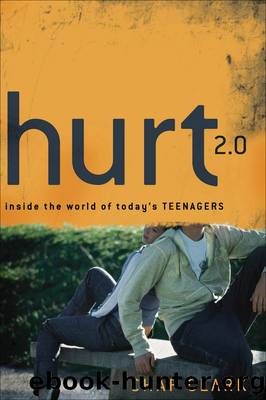Hurt 2.0 by Chap Clark

Author:Chap Clark
Language: eng
Format: epub
Publisher: Baker Publishing Group
The Impact of Stress
The ordinary effects of stress in everyday lifeâsuch as recurring headaches, insomnia, or lack of ability to concentrateâare difficult enough for adolescents to bear. Unfortunately, however, efforts to cope with stress may lead to even more serious problems such as eating disorders, substance abuse, self-injury, and suicide.[338] One of the most unsettling trends among adolescents is the rise of what experts call nonsuicidal self-injury (NSSI), where individuals deliberately inflict some form of harm (cutting, burning, hitting) on themselves without suicidal intent. In their helpful review of recent research on this issue, E. David Klonsky and Jennifer J. Muehlenkamp report that self-injury of this sort typically begins occurring around age thirteen or fourteen and is by far most prevalent among adolescents and young adults. Studies have demonstrated that at least 14 to 15 percent of adolescents in North America have engaged in some form of self-injury. Common reasons given for this behavior include âto release emotional pressure that builds up inside of me,â âto stop bad feelings,â or âto manage stress.â[339] One study of over three thousand university students conducted by Cornell and Princeton University researchers revealed that an alarming â17 percent of college studentsâ20 percent of women and 14 percent of menâreport that they have cut, burned, carved or harmed themselves in other ways.â[340] According to these researchers, this trend has led many professionals to conclude that âyoung people today possess fewer coping mechanisms and face more stressful situations than in the past.â[341]
But self-injury is just one of a number of growing destructive trends among stressed adolescents. Similarly upsetting is the link between stress and eating disorders, particularly, though not exclusively, in female adolescents. [342]And while suicide may seem to be the extreme case, recent reports have demonstrated that it is an option that presents itself to significant percentages of young people. A recent study of stress levels among college students revealed that over the past year, 16 percent of the students had friends talk about wanting to end their lives, 11 percent of the students had friends attempt suicide, and 9 percent of the students had thought seriously about ending their own life.[343] It is nothing less than tragic that adolescents feel driven to these and other destructive coping strategies in order to deal with stress. The adults in their lives must take notice and begin to ask what may be done to help alter this course.
Download
This site does not store any files on its server. We only index and link to content provided by other sites. Please contact the content providers to delete copyright contents if any and email us, we'll remove relevant links or contents immediately.
Nudge - Improving Decisions about Health, Wealth, and Happiness by Thaler Sunstein(7261)
iGen by Jean M. Twenge(5166)
The Fire Next Time by James Baldwin(5025)
Adulting by Kelly Williams Brown(4241)
The Hacking of the American Mind by Robert H. Lustig(4094)
The Sports Rules Book by Human Kinetics(4081)
The Ethical Slut by Janet W. Hardy(4042)
Captivate by Vanessa Van Edwards(3732)
Mummy Knew by Lisa James(3523)
In a Sunburned Country by Bill Bryson(3376)
The Worm at the Core by Sheldon Solomon(3328)
Ants Among Elephants by Sujatha Gidla(3282)
Suicide: A Study in Sociology by Emile Durkheim(2908)
The Slow Fix: Solve Problems, Work Smarter, and Live Better In a World Addicted to Speed by Carl Honore(2843)
The 48 laws of power by Robert Greene & Joost Elffers(2818)
Humans of New York by Brandon Stanton(2694)
Handbook of Forensic Sociology and Psychology by Stephen J. Morewitz & Mark L. Goldstein(2606)
The Happy Hooker by Xaviera Hollander(2586)
The Tipping Point by Malcolm Gladwell(2565)
